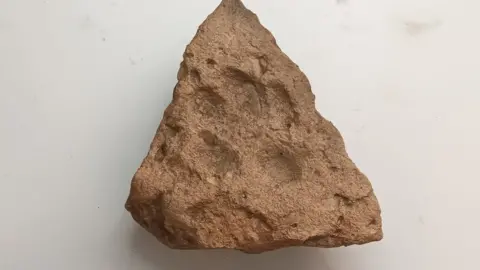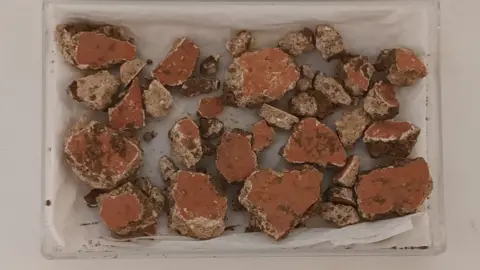Roman settlement found at Healing housing development site
 North East Lincolnshire Council
North East Lincolnshire CouncilRemains of a Roman settlement have been discovered at a housing development site in North East Lincolnshire.
Two human burials and animal bones were found at the plot, off Larkspur Avenue in Healing.
Archaeologists discovered enclosures which date back to AD200, according to North East Lincolnshire Council.
Louise Jennings, from contractor Equans, said the find would help to "broaden our understanding" of the area's past.
Developer Cyden Homes agreed to a programme of archaeological investigation on the land before it could be built on.
Work began nearly 10 years ago, according to the council, and excavations have discovered a Roman 'ladder' settlement.
 North East Lincolnshire Council
North East Lincolnshire CouncilThis comprised a linear village of enclosures, where archaeologists found evidence of a small hearth and watering holes.
They also uncovered a corn dryer, stone tools known as quern stones, and fragments of animals bones, suggesting people kept cows and sheep.
This suggested the villagers were involved in farming and the processing of crops, according to researchers.
 North East Lincolnshire Council
North East Lincolnshire CouncilTwo poorly preserved human burials have been found.
And the remains of two large buildings, one unusually with plaster on the wall, have also been discovered.
 North East Lincolnshire Council
North East Lincolnshire CouncilMs Jennings, heritage officer at Equans which operates the council's development services, said: "This allows us to broaden our understandings of North East Lincolnshire's place in history, and deepens our knowledge of what life was like at various points of the past.
"This site was inhabited for at least a few hundred years and we can see from this site the way the people here were living and adapting their settlement to suit their needs."
A final report will be prepared for North East Lincolnshire Museums Service.

Follow BBC East Yorkshire and Lincolnshire on Facebook, Twitter, and Instagram. Send your story ideas to [email protected].
